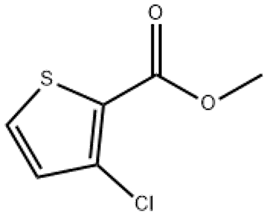METHYL 3-CHLOROTHIOPHENE-2-CARBOXYLATE(CAS# 88105-17-3)
| Hazard Symbols | Xi – Irritant |
| Risk Codes | 36/37/38 – Irritating to eyes, respiratory system and skin. |
| Safety Description | S26 – In case of contact with eyes, rinse immediately with plenty of water and seek medical advice. S36/37/39 – Wear suitable protective clothing, gloves and eye/face protection. S37/39 – Wear suitable gloves and eye/face protection |
| TSCA | N |
| HS Code | 29339900 |
Introduction
Methyl 3-chlorothiophene-2-carboxylic acid is an organic compound. The following is an introduction to its nature, use, preparation method and safety information:
Quality:
Appearance: Methyl 3-chlorothiophene-2-carboxylic acid is a colorless to light yellow liquid.
Solubility: It can be dissolved in organic solvents such as ethanol, dimethylformamide, etc.
Stability: Methyl 3-chlorothiophene-2-carboxylic acid is a relatively stable compound, but it may decompose at high temperatures.
Use:
Electrochromic agent: It can also be used as an electrochromic material (electrochromin) for electrochemical display devices and optical sensors, among others.
Method:
The preparation method of methyl 3-chlorothiophene-2-carboxylic acid usually includes the following steps:
2-carboxy-3-chlorothiophene is reacted with methanol to generate methyl 3-chlorothiophene-2-carboxylate.
Safety Information:
Methyl 3-chlorothiophene-2-carboxylic acid is an organic compound and has certain toxicity. Appropriate personal protective equipment such as gloves and goggles should be worn when in use.
Avoid direct contact with skin and eyes to avoid irritation or injury.
During handling and storage, avoid contact with substances such as oxidants and strong acids to prevent dangerous reactions.
When using or handling chemical substances, follow strict safety operating procedures and take appropriate measures according to the specific experimental environment and requirements.








